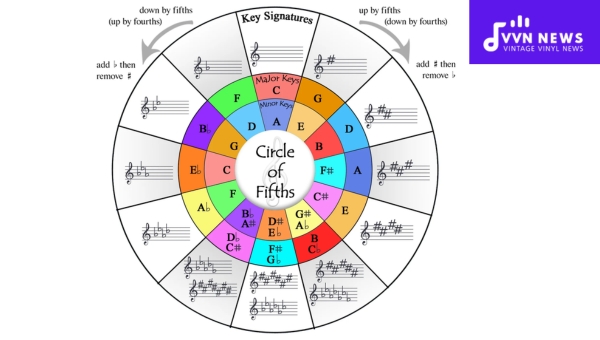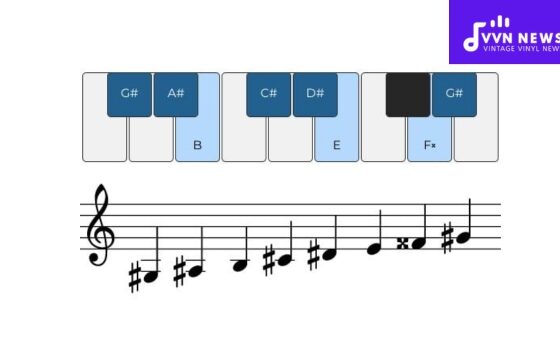Navigating the world of music theory can often feel like unraveling a complex, interwoven tapestry of sounds and symbols. One of the most essential threads woven into this intricate musical system is the Circle of Fifths.
If you’ve ever wondered what is the point of the Circle of Fifths? then this article will help demystify this fundamental concept for you. At first glance, it may seem just like a cryptic wheel filled with letters and symbols, similar to an ancient relic from an Indiana Jones movie.
But with a closer look, you’ll quickly find that it’s one of the most practical and powerful tools a musician can have under their belt serves as a roadmap that helps musicians comprehend key signatures, chord progressions, and harmonies—and that’s just scratching the surface.
What Is the Circle of Fifths?
The Circle of Fifths is a visual representation of the relationship among the 12 tones of the chromatic scale are the musical notes that form the foundation of Western music. The circular diagram arranges these twelve pitch classes in a sequence of perfect fifths.
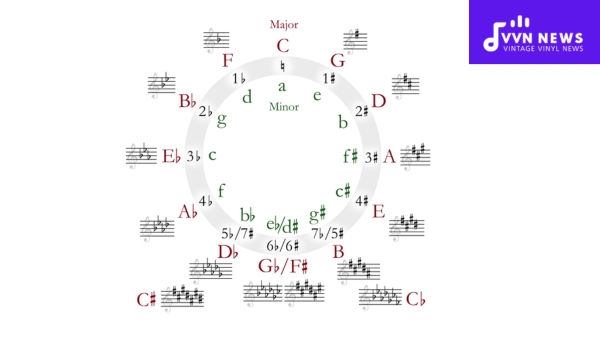
To explain further, if you start at any note on this circle and proceed clockwise, each new note you come across is a ‘perfect fifth’ or essentially five full tones away from your original note.
This unique pattern assists musicians in composing and translating music by revealing common relationships between notes.
Also Read: F Sharp Minor Pentatonic Scale [How To Use In Your Compositions]
How Does the Circle of Fifths Impact Music Composition?
The Circle of Fifths exerts a significant influence on music composition, serving as a comprehensive guide for constructing melodies and harmonies.
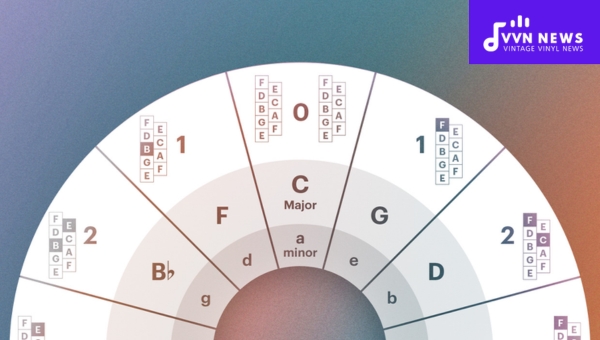
Modulation:
Arguably one of its most potent uses is modulation—the process of changing keys within a piece of music.
This can create heightened emotional impact and dramatic shifts in mood.
By adhering to the Circle of Fifths, you can ensure that your modulations sound smooth and resonate with your listeners.
Chord Progressions:
Similarly, the Circle of Fifths shapes chord progressions—the sequences of chords that give songs their narrative arc.
The Circle outlines chord relationships in such a way that common progressions, like the classic V-I (Dominant-Tonic) relationship or IV-V-I (Subdominant-Dominant-Tonic) cadence, become instantly clear.
Harmony:
Harmonization is another area where this tool comes into its own. Composers utilize it to map out key signatures and related keys comfortably, leading to more robust and intriguing harmonic structures.
A closer examination of some famous pieces across varied musical eras—from Classical masterpieces by Mozart or Beethoven to recent Pop hits—provides a testament to how integral the Circle of Fifths truly is in molding our musical landscape.
What Are the Practical Applications of the Circle of Fifths?
The Circle of Fifths has significant real-world applications for musicians, composers, and music teachers. Below are a few of its practical uses:
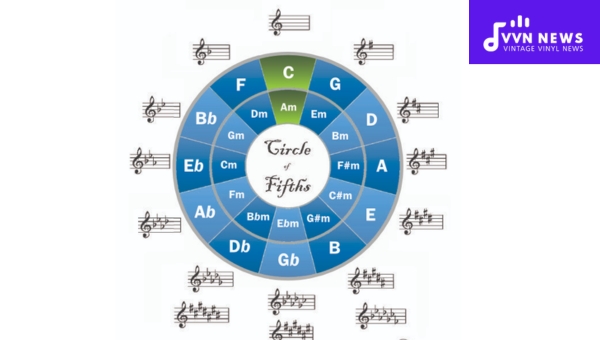
- Key Signatures: One of the key benefits of the Circle of Fifths is that it provides an arrangement of major and minor scales based on their key signatures. It’s simple to determine how many sharps or flats a key has by its position on the circle.
- Composition and Improvisation: The Circle aids in exploring chord progressions. Many popular songs use cyclic chord progressions that move in fifths, aiding musicians in both composing new songs or improvising over existing ones.
- Learning Musical Scales: For students, the Circle provides a powerful visual learning tool that aids in recall and mastery of different scales.
- Transposition: This beneficial tool helps musicians when they need to shift a piece from one key to another for either vocalists or Instrumentalists- by quickly determining what the corresponding notes would be in another key with relative ease.
- Harmonic Relationships: With harmonic relationships being at its core, it vividly explains why certain chords sound good together while others don’t.
While initially intimidating, spending sincere time with the Circle of Fifths guides you to recognize patterns within music compositions and serves as an excellent stepping stone toward musical nuance, sophistication, and personalization.
Also Read: How To Transpose Into The Tenor Clef? [Mastering In Notation]
How Does the Circle of Fifths Work?
To truly grasp how the Circle of Fifths operates, let’s start by breaking it down into digestible components.
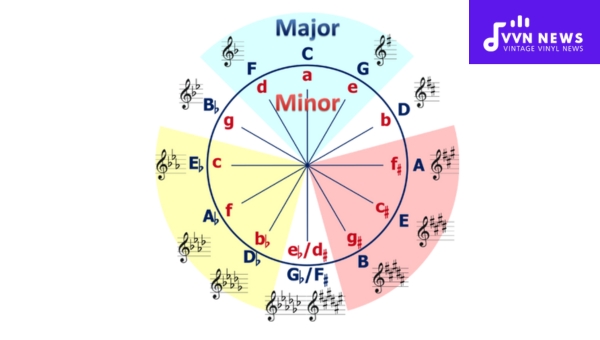
The basic structure comprises all twelve notes in an octave, arranged in a convenient order.
The Foundation: Notes and Intervals
Imagine a clock face, but instead of numbers from one to twelve, you have the names of twelve unique musical pitches distributed evenly around the circle.
Starting at the top position (usually represented with a “C”), as you move clockwise around this musical ‘wheel’, each pitch is separated by an interval known as a ‘perfect fifth’.
This pattern continues until you eventually loop back to where you began.
Navigating Through Keys
Each pitch on this wheel also denotes a key signature. The Circle of Fifths illustrates how key signatures are related to one another, displaying them in an order that highlights their similarities.
By moving clockwise or counter-clockwise, you can quickly identify which keys share similar characteristics.
Chord Progressions
In terms of harmony and chord progressions, many popular songs throughout history rely on sequences found within the Circle of Fifths.
It elegantly demonstrates relationships between major and minor keys and their corresponding chords: major chords in bold are shown outside the circle and minor chords inside.
This powerful tool encapsulates so much about music theory while presenting it in both a visually intuitive and logically sound manner. The more familiar you become with this resourceful companion, the more skilfully you can navigate through your own musical journey.
Also Read: How To Transpose Into The Tenor Clef? [Mastering In Notation]
Common Misconceptions about the Circle of Fifths
There are several misconceptions that people frequently have when it comes to the Circle of Fifths. Let’s debunk a few of these and clarify what this useful tool truly is and isn’t.
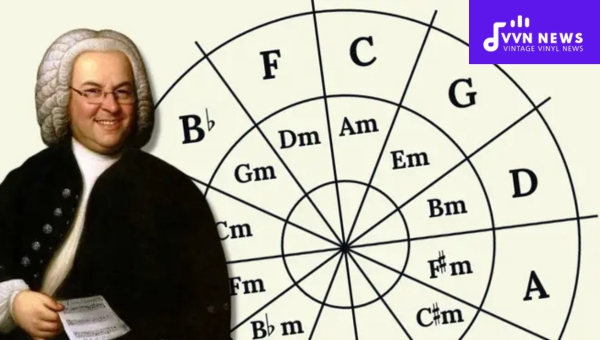
The Circle of Fifths is Only for Classical Musicians
This simply isn’t true. Although indeed widely used in classical music, the Circle of Fifths applies to all genres.
Whether you create jazz riffs, construct haunting blues melodies, experiment with pop chord progressions, or even improvise in rock performances, the Circle helps pave the way toward harmonious configurations that are pleasingly resonant.
The Circle of Fifths is Inherently Complex
Music theory contains complex concepts, but that doesn’t mean they’re out-of-bounds for learners. Certainly, the Circle may appear intricate due to its symbolic structure, it’s manageable once broken down into its components.
This visual aid is primarily designed not to complicate but to clarify musical relationships.
The Circle of Fifths Limits Creativity
Contrary to belief, this tool can increase creativity and experimentation by building a sound foundation in music theory.
You can play around with unexpected modulations or unique chord progressions when you’re confident about how different keys relate to one another.
Knowledge of Other Music Concepts Required Before Learning
This common thought may deter beginners from studying it right away. Despite being related to numerous other musical ideas and principles (like key signatures or diatonic chords), grasping these topics beforehand is not mandatory.
In truth, learning this tool can aid in comprehending these other principles more comfortably over time.
The misconceptions listed aim at discouraging learners from treading into music’s theoretical side and pushing individuals away from an incredible resource that may prove advantageous throughout their musical journey.
Also Read: Mastering Chords In A Minor [Improve Your Composition Skills]
FAQs
What is the purpose of the Circle of Fifths in music theory?
The Circle of Fifths is a visual tool that helps musicians know key relationships, modulations, and scales in Western music.
Can beginners use the Circle of Fifths effectively?
Absolutely! Beginners can use the Circle of Fifths to learn key signatures and basic chord progressions.
Does the Circle of Fifths apply to all instruments?
Yes, it applies universally across instruments, assisting in learning music theory regardless of what you play.
Is the Circle of Fifths used for composing music?
Indeed, composers utilize the circle for crafting harmonious progressions and for modulating between keys seamlessly.
How often should I practice using the Circle of Fifths?
Practice as often as possible — incorporating it into your daily practice routine can greatly enhance your musical fluency.
Also Read: Phrygian Mode [Adding Exotic Flair To Your Musical Compositions]
Conclusion
The Circle of Fifths is an extraordinary tool in your musical arsenal. It offers clarity on key signatures, guides through chord progressions, and simplifies the process of transposing music.
Remember that like any foundational aspect of music theory, it requires practice to master. Utilize this circle not just as a reference but as a stepping stone toward more intricate musical knowledge.
With each use, you’ll find yourself navigating through musical compositions with increased confidence and intuition. Embrace it as your compass in the vast sea of musical creativity.
